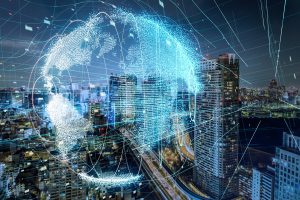It’s December 1997, I was out of work, I had no money coming in, and I was suffering from depression.
After spending a week in bed with the blinds pulled, there comes a knock at the door of the townhouse we were renting.
It’s the guy who bought my consulting firm five years earlier. He knew I had just finished living in Chile for three years, and asked if I was available to do some consulting for him.
My depression immediately lifted. I was up (I believe a bit of grace is sown into the fabric of reality. Unexpected little gifts get us started.)
The first thing I did was create a lecture on future trends. That’s because I’m a strategic planner. I help companies plan for the future.
I entitled the lecture: The four Trends of The Twenty First Century.
The four trends were: Globalism, Religious Fundamentalism, Tribalism, and Environmentalism.
I sensed there would be great tension between Globalism and the other three. I also believed at the midpoint of the twenty first century Globalism would have entirely dominated the other three trends.
I took my inspiration from Frederick Nietzsche’s writings from Greek literature on the theme of strength versus weakness. It was this model through which I passed all the events taking place between the four trends. The strong win, the weak lose. Globalism was the epitome of strength, the other three were weak.
For fifteen years I was very successful using this model. Globalism with its emphasis on open borders, digital networking, and free trade was winning hands down. My consulting took me all over the world. The world had become a powerful global economy.
However, beginning in 2009 with the global financial meltdown, and culminating with the 2012 re-election of Barack Obama, there began to be a deep mood change. People started growing negative over the strength of Globalism.
There was a growing frustration (even hostility) within the working and professional classes, that only the very rich and powerful international bankers and corporate business giants were benefiting from Globalism.
Elections in Europe began to show a definite move toward nationalism. To me nationalists were tribalists (racists, protectionists, anti-globalists).
And then boom, with the election of super nationalist Donald Trump in 2016 the western world had changed for good.
My model had to adjust to account for these fast-moving events. It was the first time since 1997 I had to rethink the strength versus weak model and the four trends that fit into it.
This time I used George Hegel’s philosophy of opposites. I collapsed tribalism and fundamentalism into one category, and called it LOCALISM. It was now Localism versus Globalism. Hegel’s point being that the tension between the opposites produces new ideas, which are a unique congealing of the contending present ideas.
What could possibly be the new idea, I asked myself. For about a year, I went back and forth experimenting with different ideas. I finally came up with a candidate: global localism.
In my mind these would be cities of moderate size that would act like powerful global city nations.
My tentative prediction is that over the next twenty years, these global city nations will have successfully competed economically on an international level, while solving some of the most vexing local social problems.
Personally, I have selected one such city to observe and study. That city is Salt Lake City, Utah. I will be particularly interested in how successfully this moderate sized global city nation fares in five areas:
1. Choking off the distance between haves and have nots
2. The ability of public/private education systems to deliver customized curriculum to the learning level of each student starting at pre-school and following through to research institutions.
3. Facilitating aggressive entrepreneurism resulting in global capital markets favoring and supporting record breaking numbers of local business startups, which lead to high revenue producing global incorporations.
4.Innovative management resulting in a world class infrastructure which decreases local traffic, ozone, and co2 levels comparable to the 25 cleanest cities in the world, while facing increased significant population growth.
5. Becoming a world competitor in facilitating the build out of a local infrastructure which results in becoming one of the world’s great leaders in free trade.
Tell me what city you would pick. and what you would want it to accomplish in the next decade or two.
